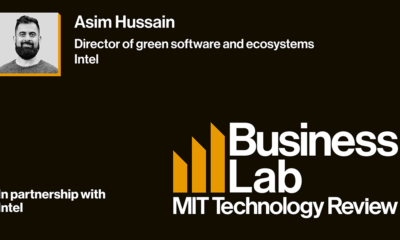Politics
Why Choosing Software is Such a Tough Decision in the Modern Era
Published
2 years agoon
By
Drew Simpson
Choosing software used to be much simpler and more straightforward. But if you’ve ever been in the position of selecting software for a business, you know that decisions are much more challenging these days. So why is this the case? And is there anything you can do to make your software selection process easier?
The Complexities of Choosing Software
There’s no denying that choosing software for your organization is a difficult and time-consuming decision. These are just some of the reasons why this is the case in the modern era:
The emergence of niche solutions.
Over the past couple of decades, we have seen an explosion in different types of niche software available. No matter what your organization needs, there’s probably a solution that’s been custom designed and built to serve that purpose. Perhaps even a lengthy name and acronym for that specific type of software.
For example, do you know the differences between CMMS and EAM software in the asset maintenance space? For the most part, this is actually a good thing. No matter what your business needs are, there’s probably already software that can address them.
Even better, there’s probably competition in the space, so you can choose between multiple different platforms serving the same function. But this also introduces complexities to the decision.
First, should you choose individual niche platforms for all of the different services you need? You can also choose a comprehensive platform that simultaneously accomplishes many different functions. Second, how niche is too niche? Do you really need a specific software platform to handle this minor problem, or is it something you can tackle on your own?
The sheer number of options
Software development is a lucrative space. If you create the right platform for the right audience, you could make a lot of money. This has attracted millions of entrepreneurs and developers to the business. Which, in turn, has created millions of options for other business owners.
Even if you’re looking for a specific type of platform, you’re probably going to find dozens, if not hundreds, of competitors to choose from when beginning your research. While we tend to think of more choices as a strictly good thing, this can ultimately bog down our selection processes and make us less satisfied with our final decisions.
Apples and oranges comparisons
How do you compare two platforms that attempt to accomplish the same goal with totally different approaches? If two platforms are functionally identical, but one costs 20 percent less, it’s easy to decide to purchase the less expensive of the two. But what if they have totally different user experiences, totally different features, and totally different price levels? When comparing apples to oranges, you can never be confident that you’re selecting the superior option.
Bureaucracies and decisions by committee
Organizations sometimes box themselves into more difficult and time-consuming decision processes because of entrenched bureaucracy and decisions made by committees. On some level, this is understandable.
Purchasing software for a large organization is a significant move, so it makes sense that multiple people shouldn’t be involved. This is also a decision that will affect many different people and many different departments. It shouldn’t be made in a vacuum by a single leader. However, it’s difficult to please everyone with every decision, and sometimes, group decision-making takes far longer than it should – and it still results in an uncertain outcome.
Security and potential vulnerabilities
Businesses need to consider the security risks involved with acquiring new software and the potential security vulnerabilities they need to address when acquiring it. This piece of the software buying puzzle is especially complicated and risky, and businesses can’t afford to gloss over it. Many businesses now have dedicated risk assessment teams whose sole job is to evaluate the potential security risks associated with software.
Contractual agreements and legal concerns
Signing a contract for a software service can be nerve-wracking, especially if you’re locking yourself into a 3-year agreement. While many software platforms are happy to have you in a floating, month-to-month agreement, an extended or complicated contract is necessary for more significant arrangements and specific platforms. Reviewing this contract means your decision will take more time. In addition, the stipulations of the contract will make your decision more complicated.
Uncertain futures: business needs
You may have a good grasp of what your business needs now and for the next few years. But, now, what is your business going to need a decade from now? Are you confident that this platform will be able to grow with your business? How can you be sure that your business won’t change in some fundamental way that eventually makes this platform irrelevant?
Uncertain futures: software development
Today’s software products are constantly growing and evolving. Software developers add and remove features as necessary, and make UI updates to improve the experience for users. Are you sure this software is headed in the right direction? How can you be sure?
How to Make Software Selection Easier
If you’re struggling to make software decisions for your organization, there are a few steps you can take to make things easier on yourself.
Start with a needs assessment
Before buying anything for your team, start your journey with a needs assessment. Too many entrepreneurs and product purchasers venture into the market with only a vague idea of what they need. They believe that shopping around will clear things up, helping them identify pain points and visualize what type of solution they need.
However, this can end up complicating things, introducing new ambiguities and new considerations that weren’t on your mind previously. Instead, focus on what you and your team actually need at the ground level, document those needs, then start looking for a solution that addresses them.
Narrow the scope of your decision
As much as possible, narrow the scope of your decision. If you’re choosing a software platform for a specific purpose with no real restrictions, you’re going to be overwhelmed with possibilities. Instead, try to eliminate at least some options immediately; for example, can you set a strict budget for yourself to eliminate all software options that exceed this budget level? Are you only going to be considering software platforms with specific features in place?
Optimize for flexibility and adaptability
Whenever you can, optimize for flexibility and adaptability. If you’re struggling between the two remaining software options, choose the one with more integrations and more customizability. Because the future is uncertain in many different respects, you’re often best off giving yourself as many future options as possible.
Compare apples to apples (however, you can)
Blockchain-based platforms aren’t all the same simply because they rely on the same type of fundamental architecture. Don’t assume that every software product within a given niche is going to perform at the same level, even if they have wildly different looks and features. It’s not always easy, and not always possible to compare different platforms in a fair and direct way – but try to compare apples to apples as much as you can.
Find developers you can trust
Rather than looking at the product only, look at the development team and the brand behind the product. Generally speaking, you’re safe making decisions based on trustworthy and competent developers, rather than the superficial appearance of a software platform.
Take a look at the leadership on this project and the skill level and experience of the developers working on this team. Is there a roadmap in place for improving this product in the future? Do the devs seem to stand by their work?
Choosing software for your business may never be easy or straightforward, but it doesn’t have to be a logistical nightmare. If you use these strategies and you’re willing to remain adaptable and continue learning skills related to software selection, eventually you’ll be in a much better position — and you’ll choose your software with confidence.
Image Credit: Vlada Karpovich; Pexels; Thank you!
Brad Anderson
Editor In Chief at ReadWrite
Brad is the editor overseeing contributed content at ReadWrite.com. He previously worked as an editor at PayPal and Crunchbase. You can reach him at brad at readwrite.com.
You may like
-


Developing climate solutions with green software
-


The Download: how NYC tackles tough problems, and China’s AI standards
-


How AI is Changing Data Management: Embracing the AI-Driven Automation Era
-


Why embracing complexity is the real challenge in software today
-


AI Agents: Adapting to the Future of Software Development
-


Involvement of Business Users in Software Development
Politics
Fintech Kennek raises $12.5M seed round to digitize lending
Published
7 months agoon
10/11/2023By
Drew Simpson
London-based fintech startup Kennek has raised $12.5 million in seed funding to expand its lending operating system.
According to an Oct. 10 tech.eu report, the round was led by HV Capital and included participation from Dutch Founders Fund, AlbionVC, FFVC, Plug & Play Ventures, and Syndicate One. Kennek offers software-as-a-service tools to help non-bank lenders streamline their operations using open banking, open finance, and payments.
The platform aims to automate time-consuming manual tasks and consolidate fragmented data to simplify lending. Xavier De Pauw, founder of Kennek said:
“Until kennek, lenders had to devote countless hours to menial operational tasks and deal with jumbled and hard-coded data – which makes every other part of lending a headache. As former lenders ourselves, we lived and breathed these frustrations, and built kennek to make them a thing of the past.”
The company said the latest funding round was oversubscribed and closed quickly despite the challenging fundraising environment. The new capital will be used to expand Kennek’s engineering team and strengthen its market position in the UK while exploring expansion into other European markets. Barbod Namini, Partner at lead investor HV Capital, commented on the investment:
“Kennek has developed an ambitious and genuinely unique proposition which we think can be the foundation of the entire alternative lending space. […] It is a complicated market and a solution that brings together all information and stakeholders onto a single platform is highly compelling for both lenders & the ecosystem as a whole.”
The fintech lending space has grown rapidly in recent years, but many lenders still rely on legacy systems and manual processes that limit efficiency and scalability. Kennek aims to leverage open banking and data integration to provide lenders with a more streamlined, automated lending experience.
The seed funding will allow the London-based startup to continue developing its platform and expanding its team to meet demand from non-bank lenders looking to digitize operations. Kennek’s focus on the UK and Europe also comes amid rising adoption of open banking and open finance in the regions.
Featured Image Credit: Photo from Kennek.io; Thank you!
Radek Zielinski
Radek Zielinski is an experienced technology and financial journalist with a passion for cybersecurity and futurology.
Politics
Fortune 500’s race for generative AI breakthroughs
Published
7 months agoon
10/11/2023By
Drew Simpson
As excitement around generative AI grows, Fortune 500 companies, including Goldman Sachs, are carefully examining the possible applications of this technology. A recent survey of U.S. executives indicated that 60% believe generative AI will substantially impact their businesses in the long term. However, they anticipate a one to two-year timeframe before implementing their initial solutions. This optimism stems from the potential of generative AI to revolutionize various aspects of businesses, from enhancing customer experiences to optimizing internal processes. In the short term, companies will likely focus on pilot projects and experimentation, gradually integrating generative AI into their operations as they witness its positive influence on efficiency and profitability.
Goldman Sachs’ Cautious Approach to Implementing Generative AI
In a recent interview, Goldman Sachs CIO Marco Argenti revealed that the firm has not yet implemented any generative AI use cases. Instead, the company focuses on experimentation and setting high standards before adopting the technology. Argenti recognized the desire for outcomes in areas like developer and operational efficiency but emphasized ensuring precision before putting experimental AI use cases into production.
According to Argenti, striking the right balance between driving innovation and maintaining accuracy is crucial for successfully integrating generative AI within the firm. Goldman Sachs intends to continue exploring this emerging technology’s potential benefits and applications while diligently assessing risks to ensure it meets the company’s stringent quality standards.
One possible application for Goldman Sachs is in software development, where the company has observed a 20-40% productivity increase during its trials. The goal is for 1,000 developers to utilize generative AI tools by year’s end. However, Argenti emphasized that a well-defined expectation of return on investment is necessary before fully integrating generative AI into production.
To achieve this, the company plans to implement a systematic and strategic approach to adopting generative AI, ensuring that it complements and enhances the skills of its developers. Additionally, Goldman Sachs intends to evaluate the long-term impact of generative AI on their software development processes and the overall quality of the applications being developed.
Goldman Sachs’ approach to AI implementation goes beyond merely executing models. The firm has created a platform encompassing technical, legal, and compliance assessments to filter out improper content and keep track of all interactions. This comprehensive system ensures seamless integration of artificial intelligence in operations while adhering to regulatory standards and maintaining client confidentiality. Moreover, the platform continuously improves and adapts its algorithms, allowing Goldman Sachs to stay at the forefront of technology and offer its clients the most efficient and secure services.
Featured Image Credit: Photo by Google DeepMind; Pexels; Thank you!
Deanna Ritchie
Managing Editor at ReadWrite
Deanna is the Managing Editor at ReadWrite. Previously she worked as the Editor in Chief for Startup Grind and has over 20+ years of experience in content management and content development.
Politics
UK seizes web3 opportunity simplifying crypto regulations
Published
7 months agoon
10/10/2023By
Drew Simpson
As Web3 companies increasingly consider leaving the United States due to regulatory ambiguity, the United Kingdom must simplify its cryptocurrency regulations to attract these businesses. The conservative think tank Policy Exchange recently released a report detailing ten suggestions for improving Web3 regulation in the country. Among the recommendations are reducing liability for token holders in decentralized autonomous organizations (DAOs) and encouraging the Financial Conduct Authority (FCA) to adopt alternative Know Your Customer (KYC) methodologies, such as digital identities and blockchain analytics tools. These suggestions aim to position the UK as a hub for Web3 innovation and attract blockchain-based businesses looking for a more conducive regulatory environment.
Streamlining Cryptocurrency Regulations for Innovation
To make it easier for emerging Web3 companies to navigate existing legal frameworks and contribute to the UK’s digital economy growth, the government must streamline cryptocurrency regulations and adopt forward-looking approaches. By making the regulatory landscape clear and straightforward, the UK can create an environment that fosters innovation, growth, and competitiveness in the global fintech industry.
The Policy Exchange report also recommends not weakening self-hosted wallets or treating proof-of-stake (PoS) services as financial services. This approach aims to protect the fundamental principles of decentralization and user autonomy while strongly emphasizing security and regulatory compliance. By doing so, the UK can nurture an environment that encourages innovation and the continued growth of blockchain technology.
Despite recent strict measures by UK authorities, such as His Majesty’s Treasury and the FCA, toward the digital assets sector, the proposed changes in the Policy Exchange report strive to make the UK a more attractive location for Web3 enterprises. By adopting these suggestions, the UK can demonstrate its commitment to fostering innovation in the rapidly evolving blockchain and cryptocurrency industries while ensuring a robust and transparent regulatory environment.
The ongoing uncertainty surrounding cryptocurrency regulations in various countries has prompted Web3 companies to explore alternative jurisdictions with more precise legal frameworks. As the United States grapples with regulatory ambiguity, the United Kingdom can position itself as a hub for Web3 innovation by simplifying and streamlining its cryptocurrency regulations.
Featured Image Credit: Photo by Jonathan Borba; Pexels; Thank you!
Deanna Ritchie
Managing Editor at ReadWrite
Deanna is the Managing Editor at ReadWrite. Previously she worked as the Editor in Chief for Startup Grind and has over 20+ years of experience in content management and content development.
